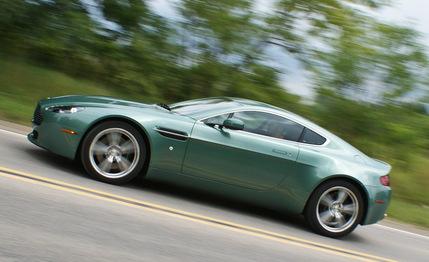 Short Take Road Test
Short Take Road Test

Aston Martin’s V-8 Vantage is the company's least expensive car, but it looks a lot like its V-12–engined big brothers, the DB9 and the DBS. Although only car nerds can distinguish which current Aston is which, the Vantage's short overhangs, taut lines, and absence of gratuitous scoops and fins make it the best-looking of the bunch. Even in DBR9 racing green—without the proper sponsorship decals, it’s a color more suited to a wedding than a racetrack—people instantly recognize it as an exotic. The interior, which is mostly shared with its more expensive siblings, looks the part. To start the car, the stainless steel and glass key, which Aston calls an "Emotion Control Unit," slides dramatically into the middle of the dash.
A Welcome Update
When we tested the Vantage on its debut in 2006, it won a comparison test against the Porsche 911. But a year later, it lost to the Porsche 911 Turbo and Audi R8 because it was too soft and too slow. Although we'd have to get all the cars together again to determine if the results would change, both issues have been addressed as part of a series of improvements that debuted for 2008.
Most notable was an increase in the V-8's displacement from 4.3 to 4.7 liters, resulting in 420 hp and 346 lb-ft of torque, increases of 40 hp and 44 lb-ft. The optional automated manual transmission's software was upgraded, the steering geometry was tweaked, Bilstein dampers were fitted, and the bushings and springs were stiffened. Our 2009 test car had the Sports Pack, which comes with even further stiffened springs, revised dampers, a unique anti-roll bar, and 19-inch split-five-spoke wheels.
The Vantage's steering is now beautifully weighted and accurate. Turn-in and body control are slop-free, and the car feels more buttoned down and predictable. Unlike many of its rear- and mid-engined competitors, the Vantage has a lot of tolerance for abrupt maneuvers. It never tries to swap ends unless you do something truly stupid. However, our test results don't bear out the better feel. The 0.93-g skidpad figure and the 70-to-0 braking distance of 165 feet are the same as we recorded before the refresh in 2007, so this car still lags the 911 Turbo and R8 significantly on these metrics.
Acceleration, on the other hand, is dramatically improved. Sixty mph arrives in 4.3 seconds, which is 0.8 second faster than before. It's also the same time we recorded in the comparo-winning Audi R8 and, more recently, the nearly twice-as-expensive Aston Martin DBS. But forget the numbers—this car's best attribute when accelerating is its wail. The exhaust note sounds better than that of anything else Aston sells in the U.S. and sends the same kind of goose bumps down your back that you get from a Ferrari V-8. Click here to hear the Vantage in action.
The Vantage's six-speed Sportshift transmission is an old-school, single-clutch, sequential-manual setup, but it has a novel "crawl" feature that makes it feel more like a conventional automatic when setting out from a stop. It launches nicely, but left in automatic mode (even with the "comfort" program selected), shifts are pronounced enough to bounce your head around. Running through the gears smoothly requires using the paddles to change cogs manually. As long as you back off the power before shifting, it's relatively seamless. Unlike the set-it-and-forget-it Porsche dual-clutch PDK, the Aston's Sportshift encourages greater driver involvement, and that's fine by us.
Nickel-and-Dimed into Our Hearts
The V-8 Vantage is the lightest and friskiest Aston Martin, and for that reason it's our favorite. Aston's middle-child DB9, which costs close to $200,000, is heavier and less nimble, and we've never tested one that accelerates as quickly as this model. The top-dog DBS pulls away from the V-8 Vantage only at high speeds, but for nearly double the price, it should. And despite higher skidpad grip, hitting the DBS's limits is a little more intimidating.
The V-8 Vantage coupe starts at $120,850, including the $1700 gas-guzzler tax and $1350 destination charge. In addition to the $3785 Sports Pack and $4000 Sportshift sequential-manual transmission, our test car came with $12,380 worth of options. Some were useful, such as the heated front seats, the upgraded stereo, Bluetooth connectivity, an alarm system, power-folding mirrors, memory seats, and a garage door opener, which totaled a fairly reasonable $4285.
Others were less clear in their value, such as the $1895 "out of range" paint (there are nice standard colors), the $795 xenon headlights (are halogens really available on this car?), the $450 black-painted brake calipers (the car will stop without black paint), a $150 battery conditioner (the battery didn't die, but should this really be an option?), the $450 cruise control (again, this is an option?), the $450 front parking sensors (if you can’t see in front of you, you probably shouldn’t be driving), the $1250 satellite radio (this is robbery), and the $2655 satellite navigation (the motorized retracting screen is cool, but it's best left closed because the revamped system is still not great).
But the options list perfectly encapsulates the V-8 Vantage in that it has, more than any other car in the low-$100,000 range, a personality that's both approachable and over the top. Its comfortable ride and spacious cabin make it a car we could drive happily every day, and it has the performance to back up its stunning styling. It's not just the least expensive Aston, it's also the most focused, most fun, and best-looking. If we could afford it, we might even call it a bargain.